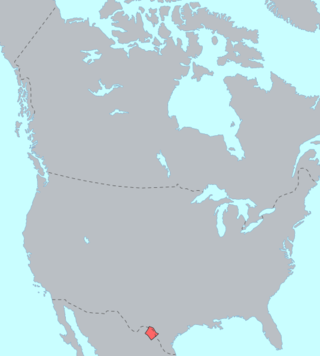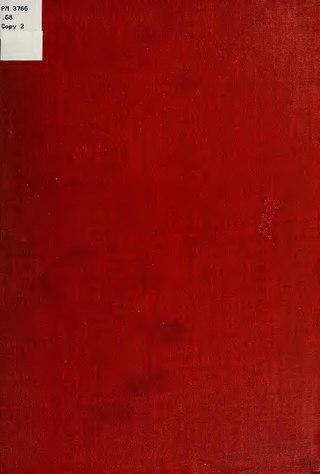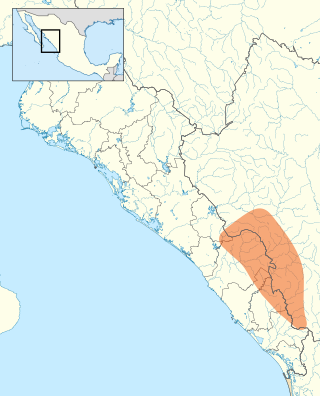Related Research Articles
This is a list of lists of extinct languages.

The Uto-Aztecan languages are a family of indigenous languages of the Americas, consisting of over thirty languages. Uto-Aztecan languages are found almost entirely in the Western United States and Mexico. The name of the language family reflects the common ancestry of the Ute language of Utah and the Nahuan languages of Mexico.

This is a list of different language classification proposals developed for the Indigenous languages of the Americas. The article is divided into North, Central, and South America sections; however, the classifications do not correspond to these divisions.

Plateau Penutian is a family of languages spoken in northern California, reaching through central-western Oregon to northern Washington and central-northern Idaho.

The Nahuan or Aztecan languages are those languages of the Uto-Aztecan language family that have undergone a sound change, known as Whorf's law, that changed an original *t to before *a. Subsequently, some Nahuan languages have changed this to or back to, but it can still be seen that the language went through a stage. The best known Nahuan language is Nahuatl. Nahuatl is spoken by about 1.7 million Nahua peoples.

Solano is an unclassified extinct language formerly spoken in northeast Mexico and perhaps also in the neighboring U.S. state of Texas. It is a possible language isolate.
The Suma were an Indigenous people of Aridoamerica. They had two branches, one living in the northern part of the Mexican state of Chihuahua and the other living near present-day El Paso, Texas. They were semi-nomadic hunter-gatherers who practiced little or no agriculture. The Suma merged with Apache groups and the mestizo population of northern Mexico, and are extinct as a distinct people.

The Mesoamerican language area is a sprachbund containing many of the languages natively spoken in the cultural area of Mesoamerica. This sprachbund is defined by an array of syntactic, lexical and phonological traits as well as a number of ethnolinguistic traits found in the languages of Mesoamerica, which belong to a number of language families, such as Uto-Aztecan, Mayan, Totonacan, Oto-Manguean and Mixe–Zoque languages as well as some language isolates and unclassified languages known to the region.
Pochutec is an extinct Uto-Aztecan language of the Nahuan branch which was spoken in and around the town of Pochutla on the Pacific coast of Oaxaca, Mexico. In 1917, it was documented in a monograph by Franz Boas, who considered the language nearly extinct. In the 1970s, another investigator found two speakers around Pochutla who still remembered a few of the words recorded by Boas.

Ópata is either of two closely related Uto-Aztecan languages, Teguima and Eudeve, spoken by the Opata people of northern central Sonora in Mexico and Southeast of Arizona in the United States. It was believed to be dead already in 1930, and Carl Sofus Lumholtz reported the Opata to have become "Mexicanized" and lost their language and customs already when traveling through Sonora in the 1890s.
The Wateree were a Native American tribe in the interior of the present-day Carolinas. They probably belonged to the Siouan-Catawba language family. First encountered by the Spanish in 1567 in Western North Carolina, they migrated to the southeast and what developed as South Carolina by 1700, where English colonists noted them.
Proto-Nahuan is a hypothetical daughter language of the Proto-Uto-Aztecan language. It is the common ancestor from which the modern Nahuan languages have developed.

The Jumanos were a tribe or several tribes, who inhabited a large area of western Texas, New Mexico, and northern Mexico, especially near the Junta de los Rios region with its large settled Indigenous population. They lived in the Big Bend area in the mountain and basin region. Spanish explorers first recorded encounters with the Jumano in 1581. Later expeditions noted them in a broad area of the Southwest and the Southern Plains.

Maratino is a poorly attested extinct language that was spoken in north-east Mexico, near Martín, Tamaulipas. Swanton, who called it 'Tamaulipeco', classified it as Uto-Aztecan based on a few obvious cognates, such as Maratino chiguat 'woman' ~ Nahuatl cihuātl 'woman' and peyot 'peyote' ~ Nahuatl peyotl, but other scholars have not considered this to be enough to classify the language.

Waikuri is an extinct language of southern Baja California spoken by the Waikuri or Guaycura people. The Jesuit priest Baegert documented words, sentences and texts in the language between 1751 and 1768.
Proto-Uto-Aztecan is the hypothetical common ancestor of the Uto-Aztecan languages. Authorities on the history of the language group have usually placed the Proto-Uto-Aztecan homeland in the border region between the United States and Mexico, namely the upland regions of Arizona and New Mexico and the adjacent areas of the Mexican states of Sonora and Chihuahua, roughly corresponding to the Sonoran Desert and the western part of the Chihuahuan Desert. It would have been spoken by Mesolithic foragers in Aridoamerica, about 5,000 years ago.
The Yojuane were a people who lived in Texas in the 16th, 17th and 18th centuries. They were closely associated with the Jumano and may have also been related to the Tonkawa. They have no connection to the Yowani in Texas, a Choctaw band.

Cazcan or Caxcan (Kaskán), was the language of the Caxcan, one of the Chichimeca peoples of Mexico. It is known only from a few word lists recorded in the 16th and 17th centuries. The language was definitely part of the Uto-Aztecan family, probably related to Huichol or possibly Southern Tepehuan. There appear to have been dialectal differences between the major Caxcan valleys, and it is likely that several other languages were spoken in Caxcan territory.

The Xixime were an indigenous people who inhabited a portion of the Sierra Madre Occidental mountains in the present day states of Durango and Sinaloa, Mexico. The Xixime are noted for their reported practice of cannibalism and resistance to Spanish colonization in the form of the Xixime Rebellion of 1610.
References
- ↑ Campbell, Goddard, Golla, Mackenzie, Mithun, & Mixco, 2007. Atlas of the World's Languages, 2nd ed, 32–43.